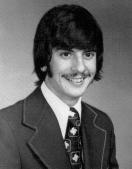David A. Stamm
For his outstanding contributions as an inventor and entrepreneur within the software industry, the Schools of Engineering are proud to present the Distinguished Engineering Alumnus Award to David A. Stamm.
Founder and Chairman of the Board
Clarify Inc.
BSEE '73
![[David A. Stamm]](Images/STAMM_100.jpeg)
On his Purdue years
I loved-although I didn't know it at the time-the hours I spent in the bottom of the math building. To write any software programs, you had to punch all your cards and then wait until the cards had been processed in order to see the results. There was a lot of camaraderie, with people milling around in the evenings and on the weekends. One of the most valuable things I realized at Purdue was that I wanted to really work on breadth, learning a little bit about a lot of things. I could combine great computer science classes and electrical engineering classes and business classes. It was always a lot of fun to see the mini-cultures that existed in the different disciplines-and sampling each of those disciplines has really paid off for me.On founding Daisy Systems
When I thought about a career, I anticipated working for a large company-a GE or a Westinghouse. But I fell in love with Intel. They had only about a thousand employees when I went to work there; I was the sixth person hired in the microprocessor design group. I found myself in the middle of the Silicon Valley revolution. I was plunged in the middle of the company and treated as an experienced engineer, even though I wasn't one. At Intel one of my office mates decided to start his own company. He was having the time of his life. I saw his company progress from the idea stage to shipping a product, and I decided that that's what I wanted to do. I spent nights and weekends with the other eventual founder of my first company, Daisy Systems, brainstorming through several different ideas. We asked a lot of questions: Is there a market for this product? Could we build it? Whom would we sell it to? We came back to one idea that was close to what we knew. Daisy Systems would build software that engineers at Intel could use to do a better job designing microprocessors. Their work would become less labor-intensive and more efficient. Daisy grew from an idea in mid-1980 to a $140 million company by the end of 1985.On founding Clarify
I love the initial stages of starting a company: creating something from nothing, raising financing, getting a skilled group of people together to help execute your plan. You have fairly little margin for error. Starting companies is what I love, and that's what people tell me I'm good at-getting the critical mass going. Once an organization grows to 300 or 400 people, then I recruit someone else. The challenge for the entrepreneur is to know when to turn over the reins. When I left Daisy Systems, I recruited people that I had worked with there to help start up another company. We decided that customer service was going to become more and more important in the business world: all of us had been on hold with the 800 numbers, trying to get technical support for computers, for example. The company we founded, Clarify, creates tools that help companies manage their customer-support calls. Microsoft, Sony, and NEC are some of our high-tech accounts. AT&T and Procter & Gamble are a few of our other clients. On current challenges Now I am helping other entrepreneurs start their own companies. I help them think through the process, and I generally end up being an investor. I invest my time and some capital; I guide and advise.On future challenges
 The Internet is going to have a profound effect on all of us in ways that we can't even figure out yet. Where the Internet goes long-term is anybody's guess. What does it mean for how we all interact? What's the societal impact? As for the global community, the laws and boundaries about information that is posted on the Internet have no
meaning. The way business is conducted
will change fundamentally.
The Internet is going to have a profound effect on all of us in ways that we can't even figure out yet. Where the Internet goes long-term is anybody's guess. What does it mean for how we all interact? What's the societal impact? As for the global community, the laws and boundaries about information that is posted on the Internet have no
meaning. The way business is conducted
will change fundamentally.- 1998:
- Clarify makes Silicon Valley Technology's Fast 50 list (for the company's growth rate) for the second time.
- 1997:
- Clarify makes Silicon Valley Technology's Fast 50 list.
- 1996:
- Outstanding Electrical Engineer, Purdue.
- 1995:
- Clarify publicly traded on NASDAQ under the symbol CLFY.
- 1993:
- Microsoft and Cisco select Clarify software to manage all customer-support calls worldwide.
- 1991:
- Co-founded Clarify Inc., which creates tools for managing customer-support calls. Named Chief Executive Officer.
- 1987-89:
- Marketing Executive Vice President, Daisy Systems. Managed all worldwide marketing functions. (Daisy manufactures software used in microprocessor design.)
- 1986-87:
- Executive Vice President. Member of triumvirate responsible for all top corporate management functions.
- 1984-86:
- General Manager, Computer-Aided Engineering Division. Managed and expanded Daisy's CAE division, which accounted for more than 75% of total profits during that period.
- 1980-84:
- Vice President, Hardware Engineering, Customer Support, and Manufacturing, Daisy Systems. Earned a patent for workstation technology. Created and staffed key positions in finance, manufacturing, field and factory support, and other groups.
- 1980:
- Co-founded Daisy Systems.
- 1974-80:
- Department Manager, High-Integration Microprocessors, Intel Corp. Created concept and circuit design for the Intel 8748, the first single-chip 8-bit microprocessor and the most second-sourced microprocessor in history.
BSEE '73, Purdue.
